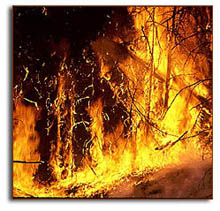Fire: Fight, Flight or Coexistence?

OVERVIEW
Wildfires: Fight, Flight, or Coexistence? has students examine the history of wildland fires and their impact on society in America. Exploring our approaches to living with fire, students will examine various fire management techniques including prescribed fires, fire suppression, and fire prevention. Students will take a closer look at the Tillamook burn in Oregon, and conduct a research project on wildfire history in another state. Students will also gain a better understanding of Smokey Bear and the role of symbols in information campaigns.
Image Caption: A wildfire in Yellowstone Park. Courtesy of NOAA Paleoclimatology Program.
OBJECTIVE
History
- The students will conduct historical research; obtaining historical data.
(Historical Thinking, Standard: 4B) - The students will identify historical issues, evaluate alternative courses of action and formulate a position or course of action on an issue.
(Historical Thinking, Standard: 5A, 5D, & 5E) - The students will learn how the rise of heavy industry and farming transformed the American people and land.
(Era 6, Contemporary United States: Standard 1) - The students will examine the ways in which institutions change over time, promote social conformity, and influence culture. They should be encouraged to use this understanding to suggest ways to work through institutional change for the common good.
(Standard V: Individuals, Groups and Institutions)
Social Studies
LESSON PLAN
Teacher Preparation:
Download and Print: Module 9 Teacher and Student PDFs using Adobe Acrobat and make one copy per student of the student pages.
For Day 1 activity: Read over the teacher's directions for Worksheet 1, then using index cards recreate worksheet 1. Each index card should have the question from the left column of worksheet 1 on one side and the corresponding right column (answer) on the other side. Be sure to read the directions to understand how this activity works before using it with students.

